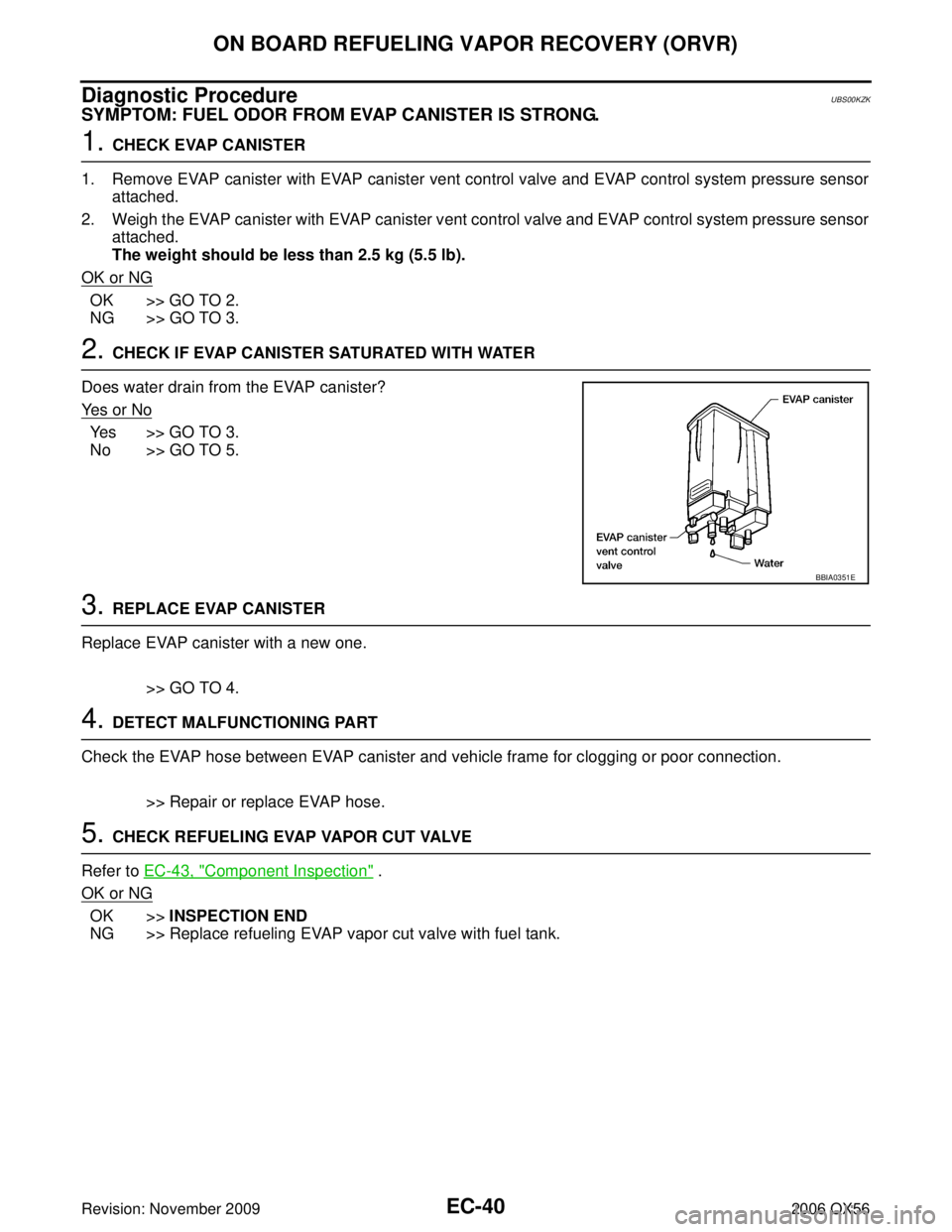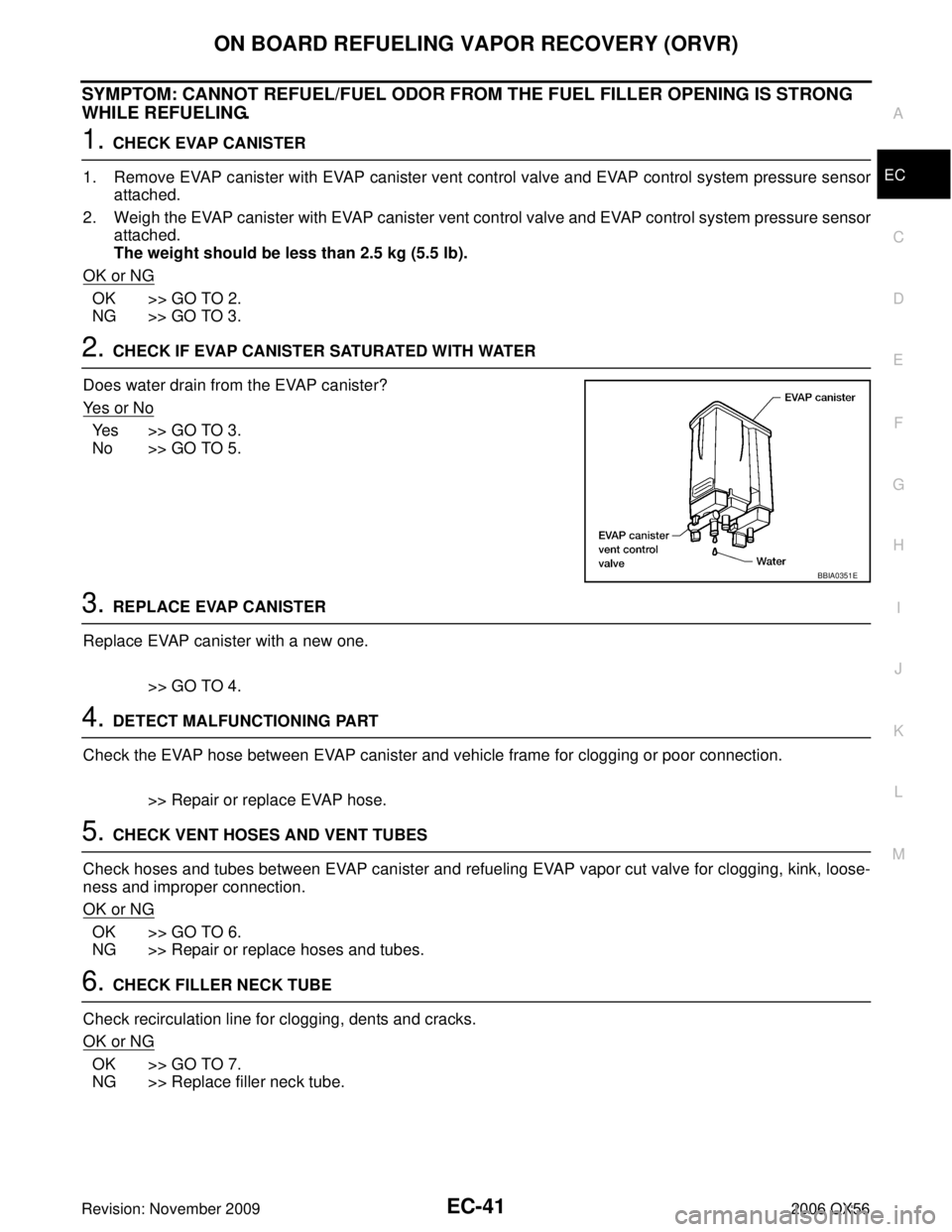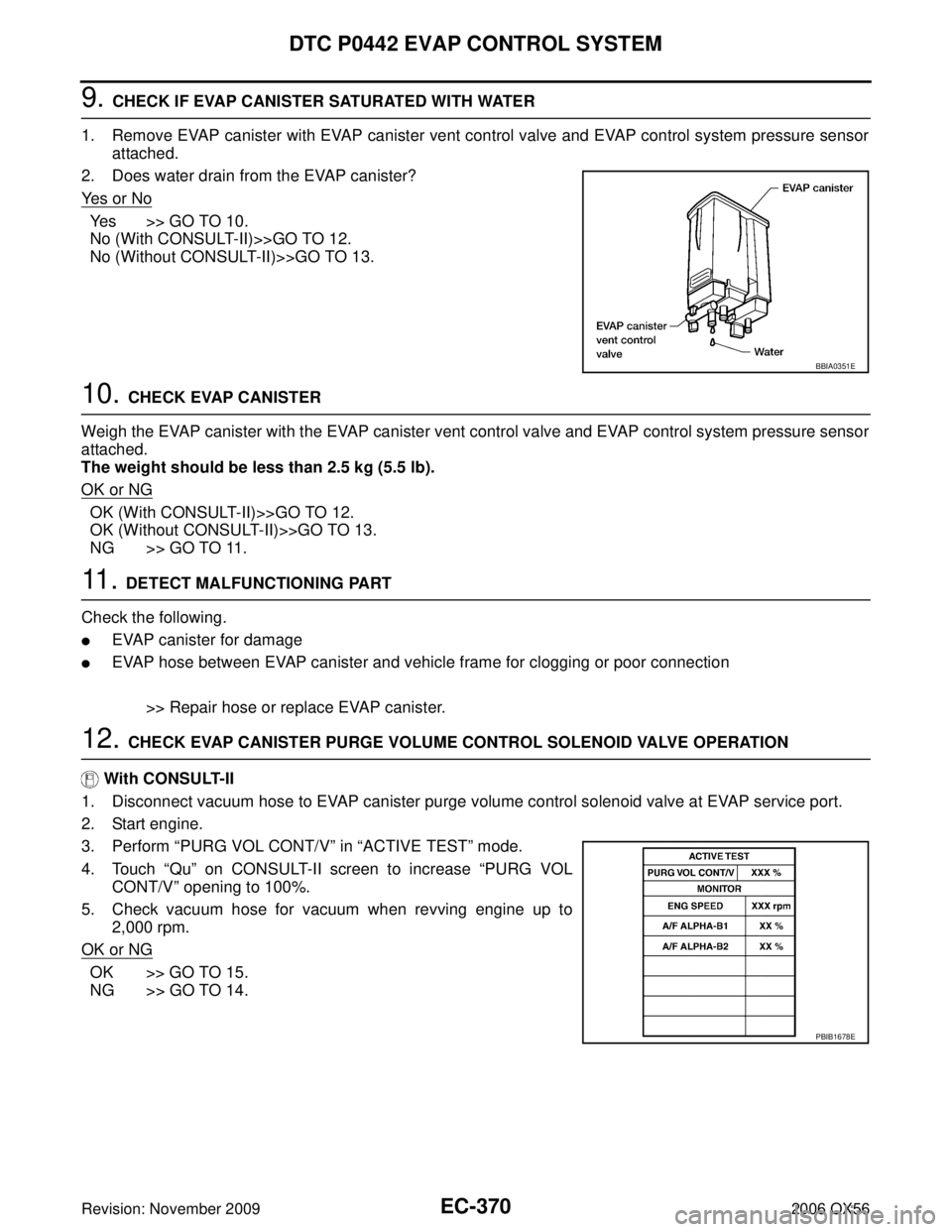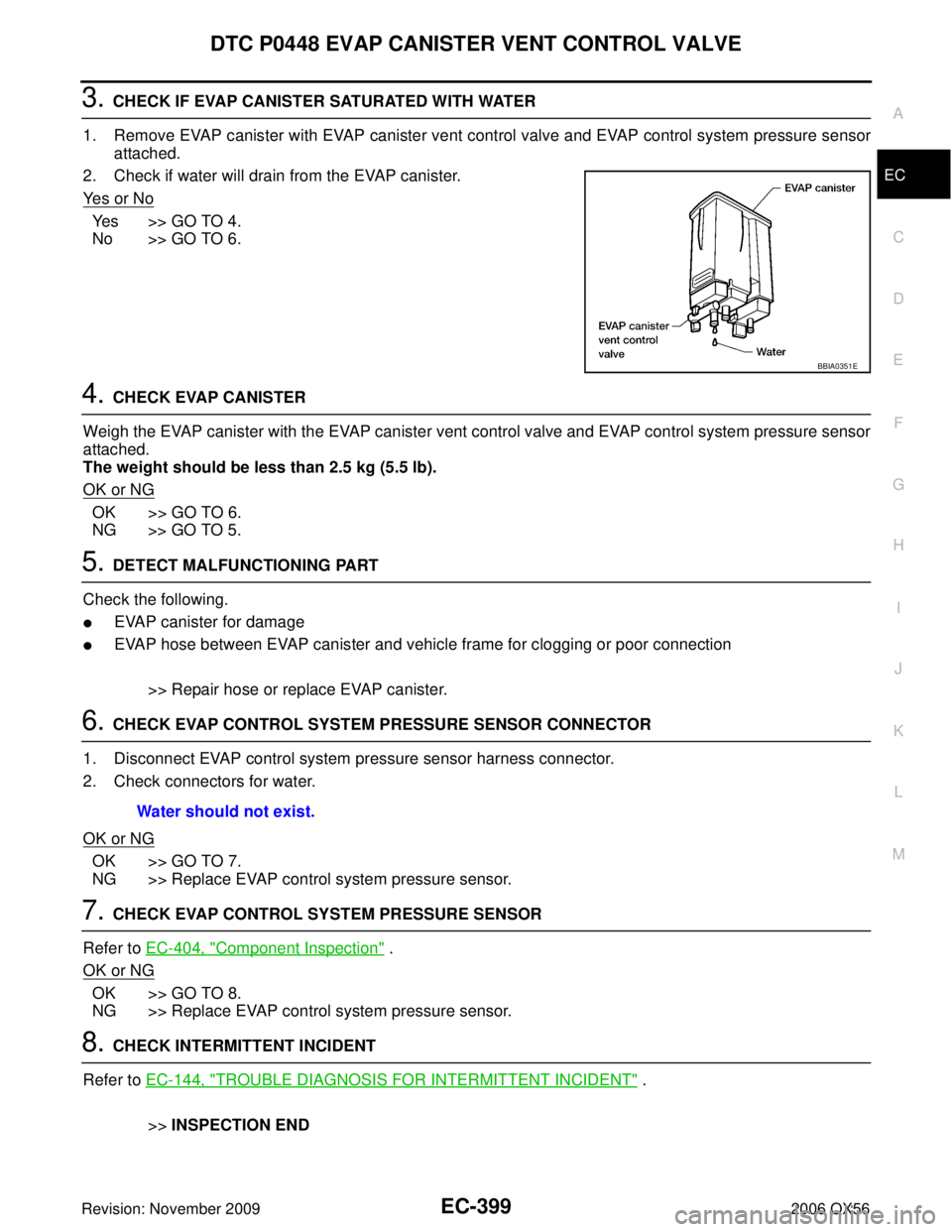Page 796 of 3383

HOODBL-15
C
DE
F
G H
J
K L
M A
B
BL
Revision: November 2009 2006 QX56
INSTALLATION
1. Pull the hood lock cable through the dash lower hole into the engine room.
Be careful not to bend the cable too much, keeping the radius
100mm (3.94 in) or more.
2. Make sure the cable is not offset from the positioning grommet, and push the grommet into the dash lower hole securely.
3. Apply sealant around the grommet at * mark.
4. Install the primary and secondary cables securely to the hood lock.
5. Install the hood lock and the secondary hood lock release assemblies.
6. Check the hood lock adjustment and hood opener operation. Refer to BL-12, "
Fitting Adjustment" .
Hood Lock Control InspectionEIS004QA
CAUTION:
If the hood lock cable is bent or deformed, replace it.
1. Remove the front grille. Refer to EI-17, "
FRONT GRILLE" .
2. Make sure the secondary latch is properly engaged with the sec- ondary striker with hood's own weight by dropping it from
approx. 200 mm (7.87 in) height.
3. While operating the hood opener, carefully make sure the front end of the hood is raised by approx. 20 mm (0.79 in). Also make
sure the hood opener returns to the original position.
4. Check the hood lock lubrication condition. If necessary, apply “body grease ” to the points shown in the figure.
5. Install the front grille. Refer to EI-17, "
FRONT GRILLE" .
PIIA0173E
PIIA0174E
PIIA1086E
PIIA0176E
Page 971 of 3383

BL-190
BODY REPAIR
Revision: November 20092006 QX56
Precautions in Repairing High Strength SteelEIS004TF
High strength steel is used for body panels in order to reduce vehicle weight.
Accordingly, precautions in repairing automotive bodies made of high strength steel are described below:
HIGH STRENGTH STEEL (HSS) USED IN NISSAN VEHICLES
SP130 is the most commonly used HSS.
SP150 HSS is used only on parts that require much more strength.
Read the following precautions when repairing HSS:
1. Additional points to consider
�The repair of reinforcements (such as side members) by heat-
ing is not recommended since it may weaken the component.
When heating is unavoidable, do not heat HSS parts above
550°C (1,022 °F).
Verify heating temperature with a thermometer.
(Crayon-type and other similar type thermometer are appro-
priate.)
�When straightening body panels, use caution in pulling any
HSS panel. Because HSS is very strong, pulling may cause
deformation in adjacent portions of the body. In this case,
increase the number of measuring points, and carefully pull
the HSS panel.
�When cutting HSS panels, avoid gas (torch) cutting if possi-
ble. Instead, use a saw to avoid weakening surrounding areas
due to heat. If gas (torch) cutting is unavoidable, allow a mini-
mum margin of 50 mm (1.97in).
Tensile strength Nissan/Infiniti designation Major applicable parts
373 N/mm
2
(38kg/mm2 ,54klb/sq in) SP130
�Front inner pillar upper
�Front pillar hinge brace
�Outer front pillar reinforcement
�Other reinforcements
785-981 N/mm
2
(80-100kg/mm2
114-142klb/sq in) SP150
�Outer sill reinforcement
�Main back pillar
PIIA0115E
PIIA0116E
PIIA0117E
Page 1251 of 3383

EC-40Revision: November 2009
ON BOARD REFUELING VAPOR RECOVERY (ORVR)
2006 QX56
Diagnostic ProcedureUBS00KZK
SYMPTOM: FUEL ODOR FROM EVAP CANISTER IS STRONG.
1. CHECK EVAP CANISTER
1. Remove EVAP canister with EVAP canister vent control valve and EVAP control system pressure sensor attached.
2. Weigh the EVAP canister with EVAP canister vent control valve and EVAP control system pressure sensor attached.
The weight should be less than 2.5 kg (5.5 lb).
OK or NG
OK >> GO TO 2.
NG >> GO TO 3.
2. CHECK IF EVAP CANISTER SATURATED WITH WATER
Does water drain from the EVAP canister?
Ye s o r N o
Yes >> GO TO 3.
No >> GO TO 5.
3. REPLACE EVAP CANISTER
Replace EVAP canister with a new one.
>> GO TO 4.
4. DETECT MALFUNCTIONING PART
Check the EVAP hose between EVAP canister and vehicle frame for clogging or poor connection.
>> Repair or replace EVAP hose.
5. CHECK REFUELING EVAP VAPOR CUT VALVE
Refer to EC-43, "
Component Inspection" .
OK or NG
OK >> INSPECTION END
NG >> Replace refueling EVAP vapor cut valve with fuel tank.
BBIA0351E
Page 1252 of 3383

ON BOARD REFUELING VAPOR RECOVERY (ORVR)EC-41
C
DE
F
G H
I
J
K L
M A
EC
Revision: November 2009 2006 QX56
SYMPTOM: CANNOT REFUEL/FUEL ODOR FROM THE FUEL FILLER OPENING IS STRONG
WHILE REFUELING.
1. CHECK EVAP CANISTER
1. Remove EVAP canister with EVAP canister vent control valve and EVAP control system pressure sensor attached.
2. Weigh the EVAP canister with EVAP canister vent control valve and EVAP control system pressure sensor attached.
The weight should be less than 2.5 kg (5.5 lb).
OK or NG
OK >> GO TO 2.
NG >> GO TO 3.
2. CHECK IF EVAP CANISTER SATURATED WITH WATER
Does water drain from the EVAP canister?
Ye s o r N o
Ye s > > G O T O 3 .
No >> GO TO 5.
3. REPLACE EVAP CANISTER
Replace EVAP canister with a new one.
>> GO TO 4.
4. DETECT MALFUNCTIONING PART
Check the EVAP hose between EVAP canister and vehicle frame for clogging or poor connection.
>> Repair or replace EVAP hose.
5. CHECK VENT HOSES AND VENT TUBES
Check hoses and tubes between EVAP canister and refueling EVAP vapor cut valve for clogging, kink, loose-
ness and improper connection.
OK or NG
OK >> GO TO 6.
NG >> Repair or replace hoses and tubes.
6. CHECK FILLER NECK TUBE
Check recirculation line for clogging, dents and cracks.
OK or NG
OK >> GO TO 7.
NG >> Replace filler neck tube.
BBIA0351E
Page 1305 of 3383

EC-94Revision: November 2009
TROUBLE DIAGNOSIS
2006 QX56
SYSTEM — ENGINE MECHANICAL & OTHER
SYMPTOMReference
page
HARD/NO START/RESTART (EXCP. HA)
ENGINE STALL
HESITATION/SURGING/FLAT SPOT
SPARK KNOCK/DETONATION
LACK OF POWER/POOR ACCELERATION
HIGH IDLE/LOW IDLE
ROUGH IDLE/HUNTING
IDLING VIBRATION
SLOW/NO RETURN TO IDLE
OVERHEATS/WATER TEMPERATURE HIGH
EXCESSIVE FUEL CONSUMPTION
EXCESSIVE OIL CONSUMPTION
BATTERY DEAD (UNDER CHARGE)
Warranty symptom code AA AB AC AD AE AF AG AH AJ AK AL AM HA
Fuel Fuel tank 5
5 FL-10
Fuel piping
5 5 5 5 55FL-4
Vapor lock —
Valve deposit 5 555 55 5 —
Poor fuel (Heavy weight gaso-
line, Low octane) —
Air Air duct
55555 5 EM-15
Air cleaner
EM-15
Air leakage from air duct
(Mass air flow sensor — electric
throttle control actuator) 5555 EM-15
Electric throttle control actuator
EM-17
Air leakage from intake manifold/
Collector/GasketEM-17
Cranking Battery
111111
11
SC-4
Generator circuit
SC-17
Starter circuit3 SC-10
Signal plate6 EM-37
Park/Neutral position (PNP)
switch4
AT- 1 0 5
Engine Cylinder head
55555 55 5EM-63
Cylinder head gasket 4 3
Cylinder block
66666 66 64
EM-78
Piston
Piston ring
Connecting rod
Bearing
Crankshaft
Va l v e
mecha-
nism Timing chain
55555 55 5 EM-37
Camshaft
EM-46
Intake valve
3EM-63
Exhaust valve
Page 1581 of 3383

EC-370Revision: November 2009
DTC P0442 EVAP CONTROL SYSTEM
2006 QX56
9. CHECK IF EVAP CANISTER SATURATED WITH WATER
1. Remove EVAP canister with EVAP canister vent control valve and EVAP control system pressure sensor attached.
2. Does water drain from the EVAP canister?
Ye s o r N o
Yes >> GO TO 10.
No (With CONSULT-II)>>GO TO 12.
No (Without CONSULT-II)>>GO TO 13.
10. CHECK EVAP CANISTER
Weigh the EVAP canister with the EVAP canister vent control valve and EVAP control system pressure sensor
attached.
The weight should be less than 2.5 kg (5.5 lb).
OK or NG
OK (With CONSULT-II)>>GO TO 12.
OK (Without CONSULT-II)>>GO TO 13.
NG >> GO TO 11.
11 . DETECT MALFUNCTIONING PART
Check the following.
�EVAP canister for damage
�EVAP hose between EVAP canister and vehicle frame for clogging or poor connection
>> Repair hose or replace EVAP canister.
12. CHECK EVAP CANISTER PURGE VOLUME CONTROL SOLENOID VALVE OPERATION
With CONSULT-II
1. Disconnect vacuum hose to EVAP canister purge volume control solenoid valve at EVAP service port.
2. Start engine.
3. Perform “PURG VOL CONT/V ” in “ACTIVE TEST ” mode.
4. Touch “Qu” on CONSULT-II screen to increase “PURG VOL
CONT/V ” opening to 100%.
5. Check vacuum hose for vacuum when revving engine up to 2,000 rpm.
OK or NG
OK >> GO TO 15.
NG >> GO TO 14.
BBIA0351E
PBIB1678E
Page 1590 of 3383
DTC P0443 EVAP CANISTER PURGE VOLUME CONTROL SOLENOID VALVEEC-379
C
DE
F
G H
I
J
K L
M A
EC
Revision: November 2009 2006 QX56
10. CHECK IF EVAP CANISTER SATURATED WITH WATER
1. Remove EVAP canister with EVAP canister vent control valve and EVAP control system pressure sensor attached.
2. Check if water will drain from the EVAP canister.
Ye s o r N o
Ye s > > G O T O 11 .
No >> GO TO 13.
11 . CHECK EVAP CANISTER
Weigh the EVAP canister with the EVAP canister vent control valve and EVAP control system pressure sensor
attached.
The weight should be less than 2.5 kg (5.5 lb).
OK or NG
OK >> GO TO 13.
NG >> GO TO 12.
12. DETECT MALFUNCTIONING PART
Check the following.
�EVAP canister for damage
�EVAP hose between EVAP canister and vehicle frame for clogging or poor connection
>> Repair hose or replace EVAP canister.
13. CHECK INTERMITTENT INCIDENT
Refer to EC-144, "
TROUBLE DIAGNOSIS FOR INTERMITTENT INCIDENT" .
>> INSPECTION END
BBIA0351E
Page 1610 of 3383

DTC P0448 EVAP CANISTER VENT CONTROL VALVEEC-399
C
DE
F
G H
I
J
K L
M A
EC
Revision: November 2009 2006 QX56
3. CHECK IF EVAP CANISTER SATURATED WITH WATER
1. Remove EVAP canister with EVAP canister vent control valve and EVAP control system pressure sensor attached.
2. Check if water will drain from the EVAP canister.
Ye s o r N o
Ye s > > G O T O 4 .
No >> GO TO 6.
4. CHECK EVAP CANISTER
Weigh the EVAP canister with the EVAP canister vent control valve and EVAP control system pressure sensor
attached.
The weight should be less than 2.5 kg (5.5 lb).
OK or NG
OK >> GO TO 6.
NG >> GO TO 5.
5. DETECT MALFUNCTIONING PART
Check the following.
�EVAP canister for damage
�EVAP hose between EVAP canister and vehicle frame for clogging or poor connection
>> Repair hose or replace EVAP canister.
6. CHECK EVAP CONTROL SYSTEM PRESSURE SENSOR CONNECTOR
1. Disconnect EVAP control system pressure sensor harness connector.
2. Check connectors for water.
OK or NG
OK >> GO TO 7.
NG >> Replace EVAP control system pressure sensor.
7. CHECK EVAP CONTROL SYSTEM PRESSURE SENSOR
Refer to EC-404, "
Component Inspection" .
OK or NG
OK >> GO TO 8.
NG >> Replace EVAP control system pressure sensor.
8. CHECK INTERMITTENT INCIDENT
Refer to EC-144, "
TROUBLE DIAGNOSIS FOR INTERMITTENT INCIDENT" .
>> INSPECTION END
BBIA0351E
Water should not exist.